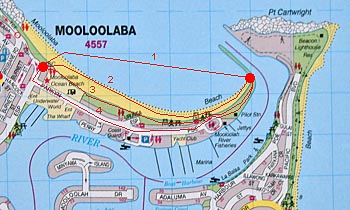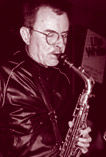6. Richard Feynman's Sum of Histories
--------------------------------------
Previous - Next - Contents
Blu 4U : by Michael Furstner
If you have listened to some of my online MP3 recordings you may have wondered
why I prefer fade outs for most of the songs rather than regular
endings. There are two reasons for that.
Firstly there are for
each style (bossa, ballad, jazz, etc.) two preprogrammed endings on my
electronic keyboard. They are quite good but of course may not always be
in character with the way I play a song. In fact in most cases they are
not.
 The second reason has a much deeper emotional and philosophical origin. I
only realised this a few days ago when, most surprisingly, I was reading
something in Brian Greene's 'The Fabric of
the Cosmos' (Chapter 7, page 180). It makes a most interesting
story I find. Here goes.
The second reason has a much deeper emotional and philosophical origin. I
only realised this a few days ago when, most surprisingly, I was reading
something in Brian Greene's 'The Fabric of
the Cosmos' (Chapter 7, page 180). It makes a most interesting
story I find. Here goes.
The Nobel laureate and brilliant 20th Century physicist Richard Feynman formulated a way of thinking
about the uncertainty in quantum
mechanics surrounding the properties and movements of the tiniest
building blocks of our universe, which appear to be both particles and
waves at the same time.
In his sum over histories principle Feynman states
that "if there are alternative ways in which a given
outcome can be achieved, then there is a sense in which the alternate
histories all happen, and happen simultaneously."
Let me explain what this means. Imagine I am standing at the very Southern
end of Mooloolaba beach, at the "Spit", the stone pier extending into the
sea (just to the left of the four high rise buildings on the
photo below).
I have had my swim, I am hungry and want to get back to the Surf
Club
(just to the right of the Life Savers watch tower in the right foreground
of the photo) for lunch.
There are four practical ways for me to get there :
- jump into the surf and swim back
- walk back along the beach
- take the walking trail through the dunes behind the beach
- or walk back on the main road farther inland
|

|
I decide to walk back along the beach and in due course arrive at the Surf
Club, no problem.
 But what if a tiny electron or a photon
(light particle-wave) were to do the same thing ? Starting from the same
point at the Spit where I walked back from it travels to the Surf Club in
an instant (at the speed of light). But when it arrives it appears as if
it has got there by using all four alternative paths : the surf, the
beach, walking trail and main road (plus many other possible pathways) all at the same time *. Weird ? Tell
me about it ! But reality, as we are starting to discover now, is quite
amazing, and very different from what we have always believed it to be.
But what if a tiny electron or a photon
(light particle-wave) were to do the same thing ? Starting from the same
point at the Spit where I walked back from it travels to the Surf Club in
an instant (at the speed of light). But when it arrives it appears as if
it has got there by using all four alternative paths : the surf, the
beach, walking trail and main road (plus many other possible pathways) all at the same time *. Weird ? Tell
me about it ! But reality, as we are starting to discover now, is quite
amazing, and very different from what we have always believed it to be.
Back to music. Strangely enough I see a clear parallel between
Feynman's sum over histories and the creativity of Jazz
improvisation. A song generally consists of two components, a
melody line and an underlying succession of chords (a socalled "chord progression") which give the song colour and mood. The
melody and chords of course do not clash but are in harmony with one
another.
Some composers start by writing the melody first, then
construct an appropriate chord progression for it. Others (like me
mostly) start with formulating a chord progression and then create a melody
line over it. Whichever way it is created once a song exists it is its
chord progression which represents the fundamental essence
of the song.
 Over a song's chord progression we can create an
infinite number of other melodies, the only restraint being that a
melody should not clash but be in harmony with the chord progression.
This is exactly what the Jazz improvisor does. He creates an
instant new melody over the given chord sequence, within the constraints
of his musical knowledge and understanding, technical skills and creative
imagination. Every performer will have his own unique approach to a song
and over time, as his familiarity and emotional insight into the song
increases, his improvisations will improve in terms of meaning and
subtlety. Over a song's chord progression we can create an
infinite number of other melodies, the only restraint being that a
melody should not clash but be in harmony with the chord progression.
This is exactly what the Jazz improvisor does. He creates an
instant new melody over the given chord sequence, within the constraints
of his musical knowledge and understanding, technical skills and creative
imagination. Every performer will have his own unique approach to a song
and over time, as his familiarity and emotional insight into the song
increases, his improvisations will improve in terms of meaning and
subtlety.
One of my teachers, the brilliant and absolute world class Australian
saxophonist Barry Duggan told me once that it had taken him 10
years (!!) to come fully to grips with Duke Ellington's composition
Satin Doll. Revealing a glimpse of Barry's depth of insight and
emotional involvement in his music.
So like in Feynman's sum over histories principle, there are
numerous improvised melodic pathways from a song's beginning to its end.
But since we are no tiny electrons or photons but large clumsy human
beings we cannot perform all possible pathways at the same time. Instead
we must be content to play our improvised melodies one after the other.
But as there are an infinite number of possible improvisations over a
song, a song never ever really ends. That is why I much prefer to fade out
at the end creating for you, the listener, the illusion that the song
continues to go on, and that only I, the performer, gradually move away
into the distance and out of the range of your ears.
The nearest thing (in terms of musical performance) to the quantum sum over histories
theory is probably the group improvisation by Trad Jazz bands (we called
them "Dixieland bands" in Holland), where trumpet, trombone, clarinet, bas, drums, piano,
banjo each follow there own unique path through the chord progression of a song, while all
playing simultaneously.
| *
| In a true life experiment the behavior of a wave-particle would of course be much more complex because of the various obstructions like trees, houses, etc. it would be blocked or deflected by on its various pathways, and because of the numerous other possible pathways a tiny wave-particle could travel to the Surf Club which a human body could not.
But my simplistic description gives you a good idea of the type of thing that is actually ocuring.
|
Next Page -
Top of Page
Copyright © 2010 Michael Furstner
|
 The second reason has a much deeper emotional and philosophical origin. I
only realised this a few days ago when, most surprisingly, I was reading
something in Brian Greene's 'The Fabric of
the Cosmos' (Chapter 7, page 180). It makes a most interesting
story I find. Here goes.
The second reason has a much deeper emotional and philosophical origin. I
only realised this a few days ago when, most surprisingly, I was reading
something in Brian Greene's 'The Fabric of
the Cosmos' (Chapter 7, page 180). It makes a most interesting
story I find. Here goes.


 Over a song's chord progression we can create an
infinite number of other melodies, the only restraint being that a
melody should not clash but be in harmony with the chord progression.
This is exactly what the Jazz improvisor does. He creates an
instant new melody over the given chord sequence, within the constraints
of his musical knowledge and understanding, technical skills and creative
imagination. Every performer will have his own unique approach to a song
and over time, as his familiarity and emotional insight into the song
increases, his improvisations will improve in terms of meaning and
subtlety.
Over a song's chord progression we can create an
infinite number of other melodies, the only restraint being that a
melody should not clash but be in harmony with the chord progression.
This is exactly what the Jazz improvisor does. He creates an
instant new melody over the given chord sequence, within the constraints
of his musical knowledge and understanding, technical skills and creative
imagination. Every performer will have his own unique approach to a song
and over time, as his familiarity and emotional insight into the song
increases, his improvisations will improve in terms of meaning and
subtlety.